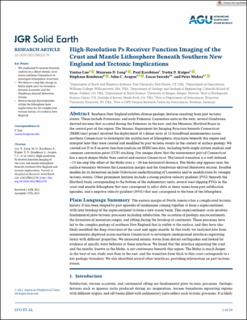| dc.contributor.author | Luo, Yantao | |
| dc.contributor.author | Long, Maureen D. | |
| dc.contributor.author | Karabinos, Paul | |
| dc.contributor.author | Kuiper, Yvette D. | |
| dc.contributor.author | Rondenay, Stephane | |
| dc.contributor.author | Aragon, John C. | |
| dc.contributor.author | Sawade, Lucas | |
| dc.contributor.author | Makus, Peter | |
| dc.date.accessioned | 2022-04-26T11:53:46Z | |
| dc.date.available | 2022-04-26T11:53:46Z | |
| dc.date.created | 2022-01-31T12:48:02Z | |
| dc.date.issued | 2021 | |
| dc.identifier.issn | 2169-9313 | |
| dc.identifier.uri | https://hdl.handle.net/11250/2992833 | |
| dc.description.abstract | Southern New England exhibits diverse geologic features resulting from past tectonic events. These include Proterozoic and early Paleozoic Laurentian units in the west, several Gondwana-derived terranes that accreted during the Paleozoic in the east, and the Mesozoic Hartford Basin in the central part of the region. The Seismic Experiment for Imaging Structure beneath Connecticut (SEISConn) project involved the deployment of a dense array of 15 broadband seismometers across northern Connecticut to investigate the architecture of lithospheric structures beneath this region and interpret how they were created and modified by past tectonic events in the context of surface geology. We carried out P-to-S receiver function analysis on SEISConn data, including both single-station analysis and common conversion point (CCP) stacking. Our images show that the westernmost part of Connecticut has a much deeper Moho than central and eastern Connecticut. The lateral transition is a well-defined, ∼15 km step-like offset of the Moho over a ∼20 km horizontal distance. The Moho step appears near the surface boundary between the Laurentian margin and the Gondwana-derived Moretown terrane. Possible models for its formation include Ordovician underthrusting of Laurentia and/or modification by younger tectonic events. Other prominent features include a strong positive velocity gradient (PVG) beneath the Hartford basin corresponding to the bottom of the sedimentary units, several west-dipping PVGs in the crust and mantle lithosphere that may correspond to relict slabs or shear zones from past subduction episodes, and a negative velocity gradient (NVG) that may correspond to the base of the lithosphere. | en_US |
| dc.language.iso | eng | en_US |
| dc.publisher | AGU | en_US |
| dc.title | High-Resolution Ps Receiver Function Imaging of the Crust and Mantle Lithosphere Beneath Southern New England and Tectonic Implications | en_US |
| dc.type | Journal article | en_US |
| dc.type | Peer reviewed | en_US |
| dc.description.version | publishedVersion | en_US |
| dc.rights.holder | Copyright 2021. American Geophysical Union. All Rights Reserved. | en_US |
| dc.source.articlenumber | e2021JB022170 | en_US |
| cristin.ispublished | true | |
| cristin.fulltext | original | |
| cristin.qualitycode | 2 | |
| dc.identifier.doi | 10.1029/2021JB022170 | |
| dc.identifier.cristin | 1994653 | |
| dc.source.journal | Journal of Geophysical Research (JGR): Solid Earth | en_US |
| dc.identifier.citation | Journal of Geophysical Research (JGR): Solid Earth. 2021, 126 (7), e2021JB022170. | en_US |
| dc.source.volume | 126 | en_US |
| dc.source.issue | 7 | en_US |
